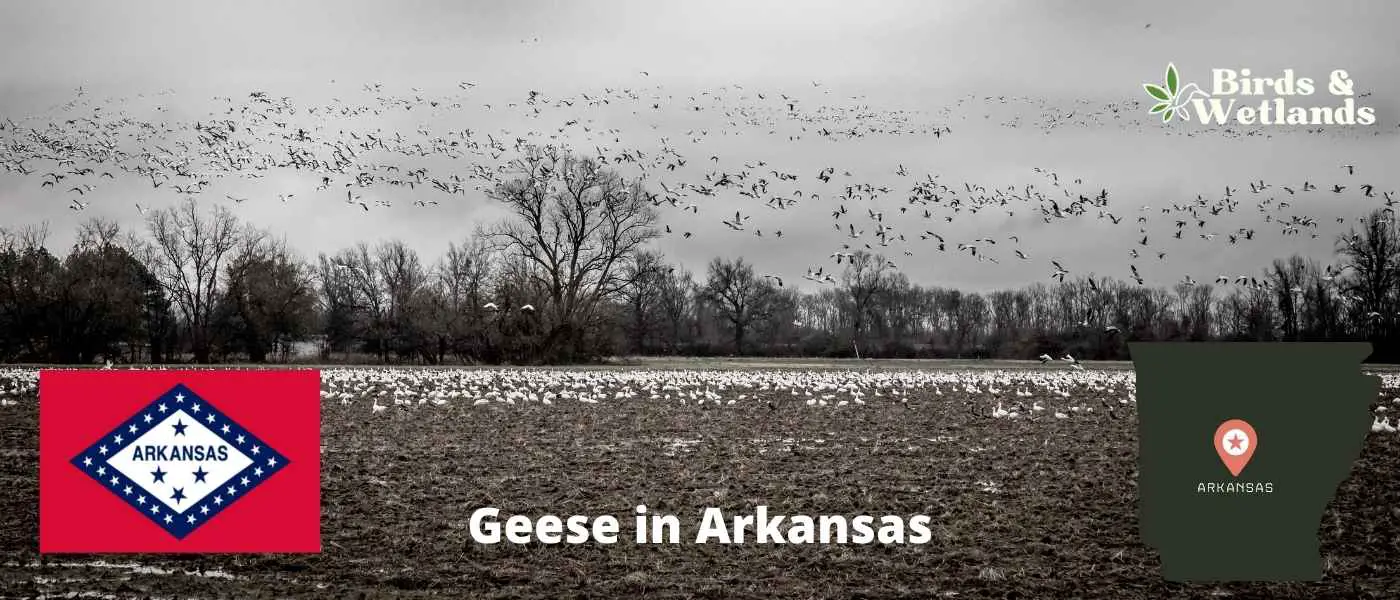There are five geese species that call Arkansas home. In this guide, we will provide a complete guide to the different types of geese found in Arkansas. We’ll discuss their physical characteristics, behavior, diet, and more!
What kind of geese are in Arkansas?
| oose | Frequency in Arkansas | Resident Population | Specific Locations in Arkansas |
|---|---|---|---|
| Canada Goose | Common | Yes | Lake Conway, Bayou Meto Wildlife Management Area |
| Snow Goose | Abundant | No | White River National Wildlife Refuge, Cache River National Wildlife Refuge |
| Ross’s Goose | Uncommon | No | Lake Dardanelle State Park, Bell Slough Wildlife Management Area |
| Cackling Goose | Uncommon | No | Holla Bend National Wildlife Refuge, Greers Ferry Lake |
| Greater White-fronted Goose | Common | No | Dale Bumpers White River National Wildlife Refuge, Stuttgart Area |
| Egyptian Goose | Newly resident | No | Lake Chicot, White River National Wildlife Refuge |
The geese present are similar to the neighboring states of Tennesse geese species and Mississippi geese species and Oklahoma geese.

Geese Species Found in Arkansas
Canada Goose


Canada Goose Sound
Scientific Name: Branta canadensis
Length: 30 to 43 in
Wingspan: 50–73 in
Weight: 5.7–14.3 lb
The Canada Goose is a large, well-known species of waterfowl noted for its distinctive appearance, familiar “honk,” and migratory behavior.
Appearance: Both male and female Canada Geese have a similar appearance, featuring a black head and neck with distinctive white patches on the cheeks and chin. The body is primarily brown with a lighter, often white, underbelly.
Diet: Canada Geese primarily feed on plant matter, including grasses, aquatic vegetation, and grains. They can often be seen grazing in parks, lawns, and fields, as well as dabbling in water bodies.
Reproduction: Canada Geese typically nest on the ground near water bodies, often on islands or other isolated areas to avoid predators. The female lays a clutch of about 4 to 6 eggs, which she incubates alone for around a month.
Snow Goose

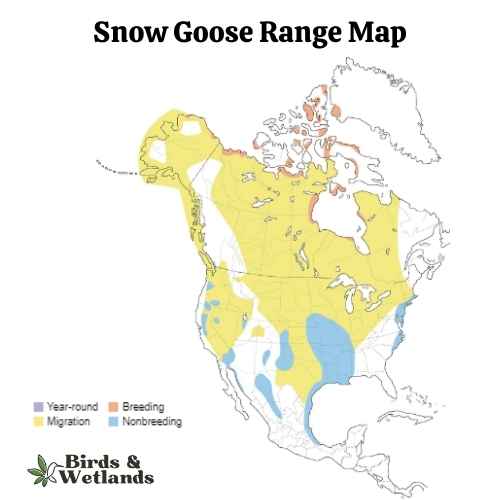
Snow Goose Sound
Scientific Name: Anser caerulescens
Length: 25 to 31 in
Wingspan: 53 to 65 in
Weight: 4.5 to 6.0
The Snow Goose is a large species of waterfowl known for its vibrant white plumage and significant migratory flights.
Appearance: True to their name, Snow Geese are predominantly white with black wingtips. They also have a pink bill, pink legs and feet. A color morph, known as the “Blue Goose,” displays a bluish-gray body with a white head, but is considered the same species.
Diet: Snow Geese primarily feed on plant matter, such as grasses, sedges, and small grains. They can often be seen in large flocks foraging in fields and marshes, and during migration and winter, they can cause considerable damage to agricultural fields due to their feeding habits.
Reproduction: Snow Geese typically nest on the tundra, near water bodies. The female builds the nest and lays a clutch of about 3 to 5 eggs, which she incubates alone for approximately three weeks. Once hatched, the goslings can feed themselves but stay with their parents for protection until they can fly.
Hunting Snow Geese in Arkansas
Snow goose hunting is permitted with a valid hunting license and during allowed shooting hours. In fact, there are so many geese present in Arkansas, they are not only destroying critical habitat for themselves and other species, but also causing problems for Arkansas farmers and local golf courses due to the huge flocks.
At present there is a no bag limit and conservation order as the Arkansas game and fish commission try to conduct eradication efforts and other population control measures on Snow Goose, Ross’s Goose and Blue goose.
In Arkansas, the snow goose population has reached staggering numbers, with approximately 3.5 million geese estimated in the midcontinent population. Snow geese have become a nuisance for farmers in the state, causing damage to their crops. Furthermore, their overabundance poses a threat to the fragile Arctic tundra, their nesting grounds.
Ross’s Goose
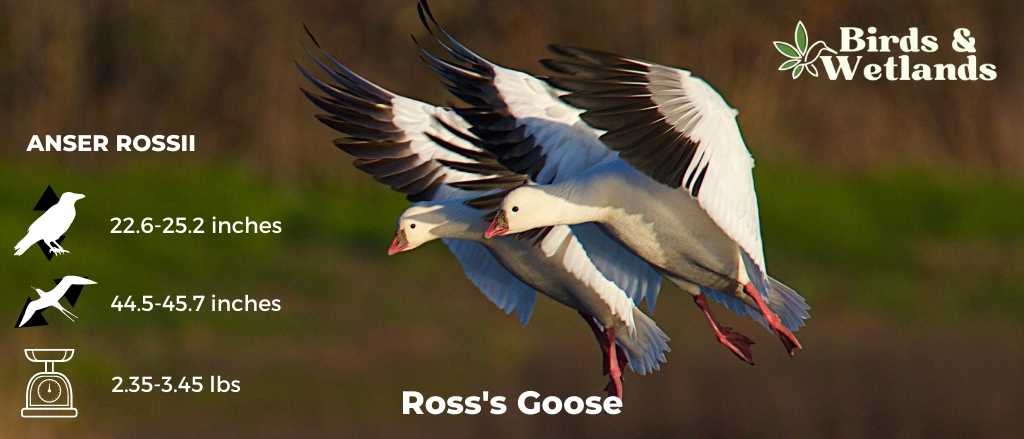
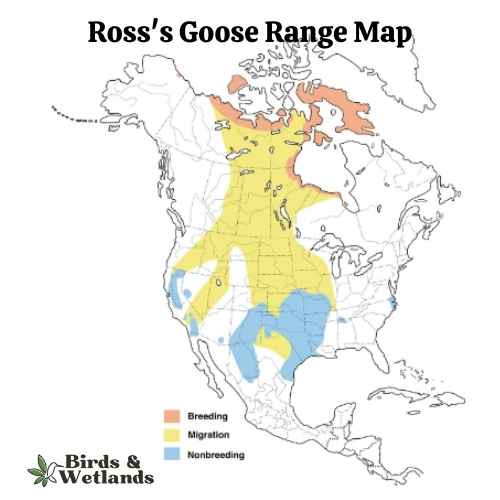
Listen
Scientific Name: Anser rossii
Length: 23.2-25.2
Wingspan: 44.5-45.7 in
Weight:42.3-55.3 oz
The Ross’s Goose is a small species of waterfowl often found in North America’s tundra and wetland habitats.
Appearance: Known for its compact size, the Ross’s Goose is mostly white with black wingtips. It features a short, stubby bill and a rounded head. One key identifying feature is the blueish gray base of its bill, which has a warty structure during the breeding season.
Diet: This goose feeds mainly on vegetation, including seeds, leaves, and roots of grasses and sedges. During winter and migration, they also consume grains and seeds from agricultural fields.
Reproduction: The Ross’s Goose nests on the ground, often in colonies. The female lays a clutch of 2 to 5 eggs which she incubates for around three weeks. The young geese, known as goslings, are precocial – they can walk, swim, and feed themselves shortly after hatching, although they stay with their parents until they learn to fly.
Greater White-fronted Goose
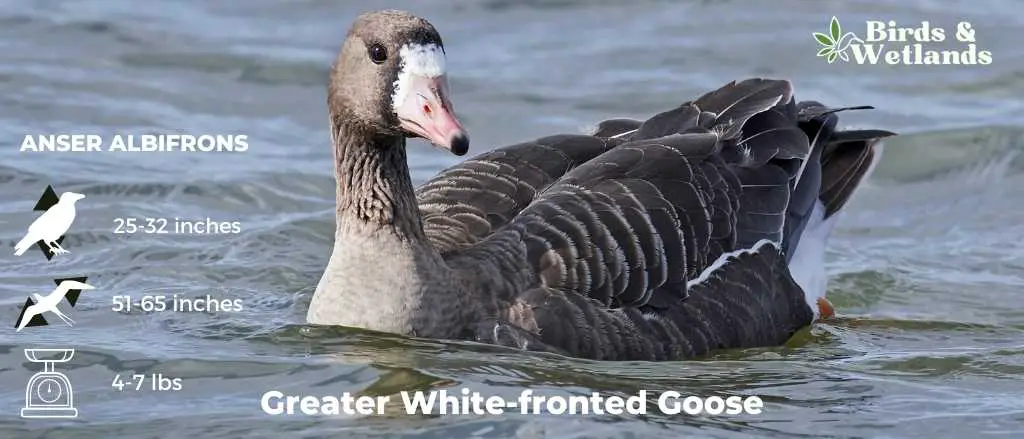

Listen
Scientific Name: Anser albifrons
Length: 25 to 31 in
Wingspan: 53 to 66 in
Weight: 3.3 to 6.6
The Greater White-fronted Goose is a medium to large waterfowl species, widely distributed across the Northern Hemisphere, particularly in North America.
Appearance: As the name suggests, these geese display a prominent white patch at the base of their bill. Their bodies are gray-brown, and their breasts are often marked with dark blotches. They possess a pinkish bill and orange legs and feet.
Diet: The Greater White-fronted Goose is a herbivore and feeds mainly on plant material. Its diet consists of grasses, sedges, grains, and berries. When wintering, these geese can often be found in agricultural fields, feasting on leftover grains and crops.
Reproduction: This species nests on the ground, often in areas with good visibility such as slopes or ridges. The female lays a clutch of 4 to 5 eggs, which she incubates for nearly a month. Once hatched, the young ones are taken care of by both parents until they are able to fly.
Cackling Goose
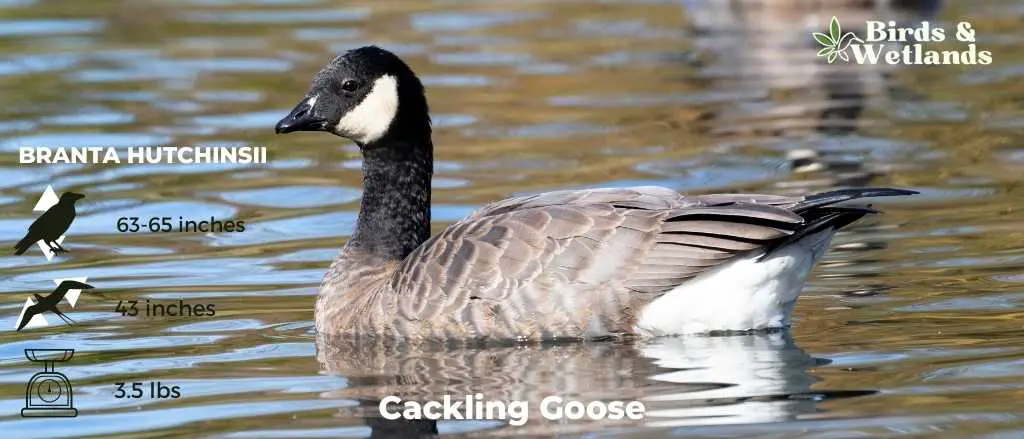
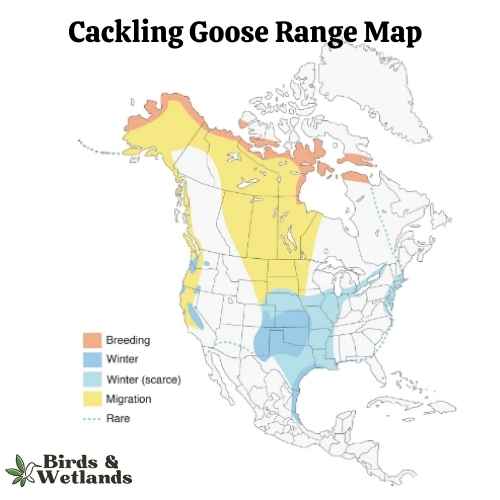
Listen
Scientific Name: Branta hutchinsii
Length: 24.8–25.6 in
Wingspan: 43-45.7 in
Weight:3.5 lbs
Cackling Geese are particularly known for their high-pitched, cackling calls, which is the source of their name. Despite their small size, these geese are renowned long-distance migrants, with some populations traveling thousands of miles between breeding and wintering grounds.
Appearance: With a similar color pattern to the larger Canada Goose, the Cackling Goose features a black head and neck, white chinstrap, light tan to cream chest, and brownish-grey body. One defining characteristic is its noticeably smaller size and stubbier neck compared to its larger counterparts.
Diet: Like many geese, the Cackling Goose’s diet mainly consists of plant matter. This includes grasses, seeds, and aquatic vegetation. They are often seen grazing on land or dabbling in shallow water.
Reproduction: Cackling Geese usually nest on the ground in elevated areas near water bodies, such as riverbanks or lakeshores. The female lays a clutch of 2 to 8 eggs and is responsible for incubation, while the male stands guard nearby. Incubation lasts for about a month.
Egyptian Goose
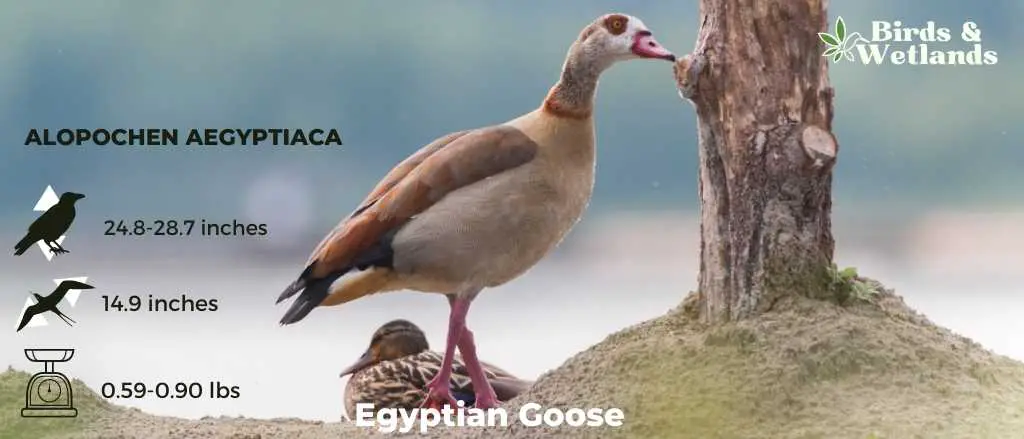

Listen
Scientific Name: Alopochen aegyptiaca
Length: 24.8 to 28.7 cm
Wingspan: 38 cm
Weight:1.5 to 2.3 kgs
The Egyptian Goose is a distinct waterfowl species celebrated for its unique coloration and adaptability to various environments.
Appearance: Egyptian Geese are quite striking, displaying a combination of brown, white, and grey feathers. They also have a chestnut patch around their eyes and on the chest, along with a distinctive dark brown ring around their lower neck. Their pink legs and feet and pinkish bill stand out against their body color.
Diet: The diet of the Egyptian Goose primarily consists of plant matter. They feed on grasses, seeds, leaves, and crops, and can often be seen grazing in fields and on the water’s edge.
Reproduction: Egyptian Geese typically make their nests in a variety of places including tree cavities, reed beds, and cliffs. The female lays a clutch of 5 to 12 eggs, which she incubates for about a month.
Originally native to Africa, the Egyptian Goose has established populations in parts of the United States, where it was introduced through the pet trade. Despite not being native, they have adapted well to American habitats, particularly in suburban and urban areas where they can often be seen in parks and on golf courses.
In Arkansas, you are allowed to use full-body decoys and electronic calls, along with a no possession limit to try and reduce the large flocks of these two species, so hunters can enjoy some great hunting with the large spread. Allowing increased harvest in waterfowl hunting is one socially acceptable way that these flocks are kept manageable.
The Arkansas Game and Fish Commission has been working with the University of Arkansas’s Cooperative Wildlife Research Unit to study recent increases in nonnative Egyptian Geese.
Where to Spot Arkansas’s Geese
Bayou Meto Wildlife Management Area: Located southeast of Little Rock, Bayou Meto WMA is renowned for its Arkansas waterfowl populations, including a variety of geese and lots of Arkansas ducks. This expansive wetland offers excellent opportunities to observe geese in their natural habitat.
White River National Wildlife Refuge: Situated in eastern Arkansas, the White River NWR encompasses diverse habitats that attract a wide range of waterfowl, including geese. The refuge’s wetlands, bottomland hardwood forests, and rice fields provide prime feeding and resting grounds for these migratory birds.
Lake Conway: Located near Conway, Arkansas, Lake Conway is a popular destination for birdwatching enthusiasts. This reservoir attracts various waterfowl species, including geese, offering opportunities for observation and photography.
Greers Ferry Lake: Situated in the Ozark Mountains, Greers Ferry Lake provides a scenic backdrop for birdwatching. This reservoir attracts waterfowl, including geese, particularly during migration seasons and lots of Arkansas birds of prey.
Stuttgart Area: Known as the “Rice and Duck Capital of the World,” the Stuttgart area in Arkansas is a hub for waterfowl activity. Geese, including snow geese, frequent the rice fields and wetlands in this region, offering remarkable opportunities for birdwatchers.

